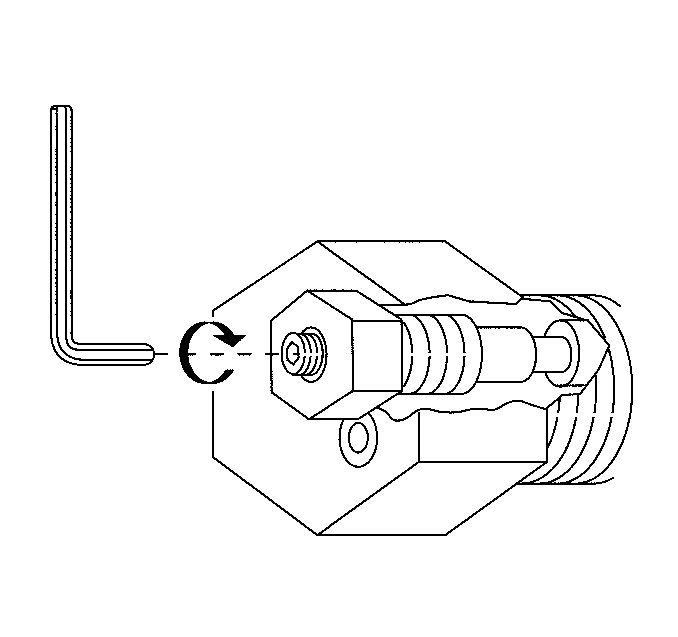- With a scan tool communicate with the Alternative Fuels ECM.
- Store the DTC Information for any Alternative Fuels ECM DTCs that may be set.
- Clear all Alternative Fuels ECM DTC Information and then turn the ignition OFF.
- Start and idle the engine.
- With a scan tool, select the high pressure lock-off (HPL) solenoid special function.
- While the engine is operating on CNG command the HPL OFF and observe the fuel tank pressure sensor data parameter. The fuel tank pressure should slowly decrease.
- Remove the fuel tank cover. Refer to Fuel Tank Cover Replacement .
- Close the manual lock-down screw located on the high pressure lock-off (HPL) solenoid manual shut-off fitting by rotating the allen screw clockwise until fully seated.
- Turn OFF the ignition.
- Disconnect the negative battery cable. Refer to Battery Negative Cable Disconnection and Connection in Engine Electrical in the C/K Pickup service manual.
- Slowly loosen the fuel line fitting (1) at the low pressure lock-off (LPL) inlet port (2) several turns. Fuel pressure should vent from the line for a few seconds.
- Slowly loosen the fuel line fittings at the tee (5) and at the check valve (7) several turns.
- Fuel Pressure Relief for the CNG system is complete when the fuel lines can be pulled away from the O-ring face seal and fuel does not vent.
- Replace the O-ring face seals at all fittings that were disconnected or loosened.
- After all necessary repairs are complete perform the following:
- If the service necessary for the vehicle requires the CNG fuel TANK be relieved of all internal pressure, refer to Fuel Tank Venting .
If communication cannot be established and the Diagnostic System Check - Alternative Fuels (Engine Controls) has already been performed proceed to Step 7.
Important: If the engine fails to operate on CNG or start at all, proceed to Step 7.
Ensure that the engine is operating on CNG by observing that the fuel indicator lamp (FIL) is OFF and that both the AFO Signal and the AFO Signal Command scan tool displays (Engine Data-Alt. Fuels) indicate the AFECM is in command of engine fueling.
If the fuel pressure fails to decrease proceed to Step 7.
When the engine stalls or a switch-over to gasoline is observed, perform the following:
| 6.1. | Turn OFF the ignition. |
| 6.2. | Remove the CNG 20-amp fuse in order to disable the CNG fuel system. |
| 6.3. | A small amount of CNG will remain in the fuel lines and components. Slowly open the fittings in order to release any remaining pressure when disconnecting a fuel line. |
| 6.4. | Fuel Pressure Relief for the CNG system is now complete. Proceed to Step 16. |


Caution: When relieving the Compressed Natural Gas (CNG) fuel system pressure,
take the following precautions in order to prevent fire and personal injury:
• Vent the CNG fuel system in a well ventilated work
area. • Keep sparks, flames, and smoking material away from the area. • Wear the appropriate hearing protection during the venting procedure.
A sudden pressure loss from an uncontrolled gas leak can cause hearing damage.

Caution: Natural gas is stored under high pressure. If a leak occurs, the high pressure could cause a personal injury. In order to prevent Compressed Natural Gas (CNG) fuel leaks, always replace the CNG fuel system O-rings during service.
| 15.1. | Tighten any loosened fittings to the correct torque. Refer to Fastener Tightening Specifications . |
| Important: Leave the manual lock-down screw CLOSED on any vehicle that will require CNG fuel tank venting. |
| 15.2. | Open the manual lock-down screw located on the HPL manual shut-off fitting by rotating the allen screw counter-clockwise until fully seated on any vehicle that does not require venting of the CNG fuel TANK. |
Important: If the service necessary for the vehicle requires that the ignition be turned ON with CNG components or lines disconnected, keep the CNG 20 amp fuse removed in order to prevent CNG fuel venting during an ignition ON prime pulse.
